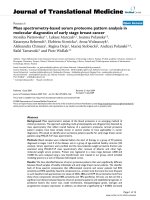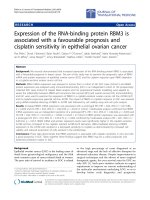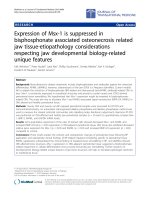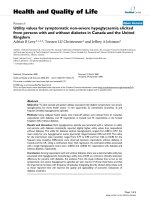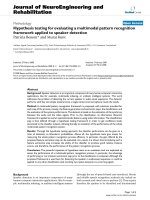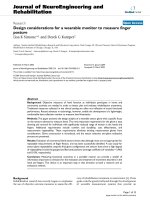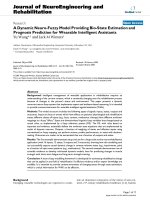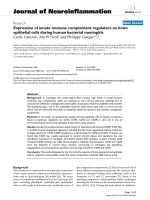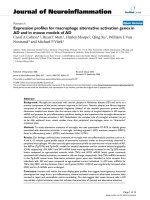báo cáo hóa học: " Expression profiles for macrophage alternative activation genes in AD and in mouse models of AD" pptx
Bạn đang xem bản rút gọn của tài liệu. Xem và tải ngay bản đầy đủ của tài liệu tại đây (630.21 KB, 12 trang )
BioMed Central
Page 1 of 12
(page number not for citation purposes)
Journal of Neuroinflammation
Open Access
Research
Expression profiles for macrophage alternative activation genes in
AD and in mouse models of AD
Carol A Colton*
1
, Ryan T Mott
1
, Hayley Sharpe
2
, Qing Xu
1
, William E Van
Nostrand
3
and Michael P Vitek
1
Address:
1
Duke University Medical Center, Division of Neurology, Durham, NC 27710, USA,
2
University of Bath, Department of Biology and
Biochemistry, Clavertone Down, Bath, BA2 7AY, UK and
3
Department of Medicine, Stony Brook University, Stony Book NY 11794, USA
Email: Carol A Colton* - ; Ryan T Mott - ; Hayley Sharpe - ;
Qing Xu - ; William E Van Nostrand - ; Michael P Vitek -
* Corresponding author
Abstract
Background: Microglia are associated with neuritic plaques in Alzheimer disease (AD) and serve as a
primary component of the innate immune response in the brain. Neuritic plaques are fibrous deposits
composed of the amyloid beta-peptide fragments (Abeta) of the amyloid precursor protein (APP).
Numerous studies have shown that the immune cells in the vicinity of amyloid deposits in AD express
mRNA and proteins for pro-inflammatory cytokines, leading to the hypothesis that microglia demonstrate
classical (Th-1) immune activation in AD. Nonetheless, the complex role of microglial activation has yet
to be fully explored since recent studies show that peripheral macrophages enter an "alternative"
activation state.
Methods: To study alternative activation of microglia, we used quantitative RT-PCR to identify genes
associated with alternative activation in microglia, including arginase I (AGI), mannose receptor (MRC1),
found in inflammatory zone 1 (FIZZ1), and chitinase 3-like 3 (YM1).
Results: Our findings confirmed that treatment of microglia with anti-inflammatory cytokines such as IL-
4 and IL-13 induces a gene profile typical of alternative activation similar to that previously observed in
peripheral macrophages. We then used this gene expression profile to examine two mouse models of AD,
the APPsw (Tg-2576) and Tg-SwDI, models for amyloid deposition and for cerebral amyloid angiopathy
(CAA) respectively. AGI, MRC1 and YM1 mRNA levels were significantly increased in the Tg-2576 mouse
brains compared to age-matched controls while TNF
α
and NOS2 mRNA levels, genes commonly
associated with classical activation, increased or did not change, respectively. Only TNF
α
mRNA increased
in the Tg-SwDI mouse brain. Alternative activation genes were also identified in brain samples from
individuals with AD and were compared to age-matched control individuals. In AD brain, mRNAs for
TNF
α
, AGI, MRC1 and the chitinase-3 like 1 and 2 genes (CHI3L1; CHI3L2) were significantly increased while
NOS2 and IL-1
β
mRNAs were unchanged.
Conclusion: Immune cells within the brain display gene profiles that suggest heterogeneous, functional
phenotypes that range from a pro-inflammatory, classical activation state to an alternative activation state
involved in repair and extracellular matrix remodeling. Our data suggest that innate immune cells in AD
may exhibit a hybrid activation state that includes characteristics of classical and alternative activation.
Published: 27 September 2006
Journal of Neuroinflammation 2006, 3:27 doi:10.1186/1742-2094-3-27
Received: 25 July 2006
Accepted: 27 September 2006
This article is available from: />© 2006 Colton et al; licensee BioMed Central Ltd.
This is an Open Access article distributed under the terms of the Creative Commons Attribution License ( />),
which permits unrestricted use, distribution, and reproduction in any medium, provided the original work is properly cited.
Journal of Neuroinflammation 2006, 3:27 />Page 2 of 12
(page number not for citation purposes)
Background
As part of the innate immune system, macrophages rap-
idly respond to a large variety of pathological molecular
pattern stimuli (PAMPS) such as bacterial coat and viral
proteins [1,2]. The programmed response to acute stimuli
includes the induction of a specific gene profile and the
subsequent production of multiple cytoactive factors such
as TNFα, NO and IL-1 that protect against tissue invaders.
In peripheral macrophages, this first phase of an innate
immune response has been described as classical immune
activation [1-3]. "Classical activation" is also character-
ized by the involvement of Th-1 cytokines such as inter-
feron-γ (IFN-γ), a "master" cytokine that orchestrates the
coordinated induction and production of the "killing"
phase [4-6]. However, the gene profile of macrophages
can change, shutting down the production of pro-inflam-
matory cytokines and increasing the production of factors
that participate in tissue repair and wound healing [6].
Anti-inflammatory, Th-2 cytokines such as IL-10 and
TGFβ are associated with broad ranging and potent inhi-
bition of pro-inflammatory activity while other Th-2
cytokines such as IL-4 and IL-13 serve to antagonize IFN-
γ, are anti-parasitic, mediate allergic responses and induce
tissue matrix reconstruction [6,7]. IL-4 and IL-13 -medi-
ated gene induction has been specifically termed alterna-
tive activation and includes genes that produce arginase I
(AG1), mannose receptors (MRC1) and genes associated
with tissue remodeling such as Found in Inflammatory
Zone 1 (FIZZ1) and chitinase 3-like 3 (YM1) [8-11].
The induction of the genes characteristic of alternative
activation during an immune response provides an anti-
inflammatory balance to an acute, pro-inflammatory
response. Consequently, alternatively activated macro-
phages are viewed as immunosuppressive and involved in
tissue repair and extracellular matrix remodeling [5,6].
However, alternatively activated macrophages may also
contribute to disease processes in a complex way. For
example, alternatively activated alveolar macrophages
contribute to the fibrotic lesion in idiopathic pulmonary
fibrosis [11] and in the liver fibrosis associated with Schis-
tosoma mansoni [12].
Although classical and alternative activation are com-
monly viewed as the two opposing ends of macrophage
activation, additional activation states may also exist
[5,6]. For example, Anderson and Mosser [13] have
described a third class of macrophages, called Type II mac-
rophages. This state requires a specific two step activation
pattern that involves ligation of Fcγ receptors and signal-
ing through Toll receptors, CD40 or CD44 [5,13,14]. The
end result is decreased IL-12 expression concomitant with
increased IL-10 mRNA. As a consequence, the gene profile
of Type II macrophages is a mixture of pro-inflammatory
and anti-inflammatory genes such as IL-1, TNF-a, IL-6, IL-
10 and IL-4 [15]. Arginase, however, is not induced. A
"deactivation" state of macrophages that is similar to Type
II macrophages has also been described by Gordon [6].
Alzheimer's disease (AD) is characterized pathologically
by extracellular fibrillar deposits in the parenchyma of the
brain which are composed of the β-amyloid (Aβ) peptide
1–40 and 1–42 fragments of the amyloid precursor pro-
tein (APP) [16-18]. It is generally believed that soluble
APP and various forms of Aβ peptides, either alone or in
conjunction with other immune factors, serve as activat-
ing signals for an innate immune response in the brain
[19]. Using immunocytochemistry, Griffin et al [20] have
demonstrated the presence of IL-1β in microglia and
astrocytes surrounding the amyloid deposits. Other inves-
tigators have confirmed these findings and have also
shown that IL-6, TNFα and MHC expression is increased
in AD [21-25]. As a result, AD has been associated with
classical immune activation and the production of an
acute Th-1 immune response. However, AD is a chronic
neurodegenerative disease in which the inflammatory
process has not been thoroughly charted over time and
with disease progression. It is highly likely that brain mac-
rophages may change their activation state as a function of
the disease and time. To assess this possibility, we have
determined if genes associated with alternative activation
are expressed in cortical samples from individuals with
AD compared to cognitively normal aged matched control
individuals. Additionally, we investigated the alternative
activation-related gene expression profiles in mouse mod-
els of AD and of cerebral amyloid angiopathy. Our data
demonstrate that genes typical of alternative activation are
clearly expressed in AD and in a mouse model of amyloid
deposition. However, it is likely that the macrophage acti-
vation state in AD represents a novel hybrid state between
classical and alternative activation.
Materials and methods
Cell cultures and treatment conditions
BV2 microglia were used as a model of CNS murine
microglia and have been extensively characterized [26].
For some experiments, primary murine microglia were
also used and were prepared from mixed glial cultures
from 2 day old postnatal pups in a standard fashion [27].
Cells from both cultures were maintained in 75 cm
2
flasks
at 37°C in a 5% CO
2
humidified atmosphere in Dul-
becco's Modified Eagle Medium (DMEM) with high glu-
cose (4.5 g/L D-glucose, L-glutamine, pyridoxine HCl, and
110 mg/L sodium pyruvate; Invitrogen, Carlsbad, CA,
USA) containing 10% fetal bovine serum, 100 U/ml pen-
icillin, and 100 μg/ml streptomycin. For each experiment,
cells were plated into 24 well dishes, after which the
media was changed to the treatment media consisting of
serum free DMEM with low glucose (1.0 g/L D-glucose, L-
glutamine, pyridoxine HCl, and 110 mg/L sodium pyru-
Journal of Neuroinflammation 2006, 3:27 />Page 3 of 12
(page number not for citation purposes)
vate; Invitrogen). Cells were then allowed to adapt to the
serum-free media for 24 hours before starting the experi-
ments. The stimulants used for the cell culture experi-
ments included recombinant mouse IFN-γ (100 U/ml,
BioSource International Inc., Camarillo, CA, USA) and
recombinant mouse IL-4 or IL-13 (20 ng/ml, BioSource
International). Treatments were carried out in fresh
serum-free media for 24 hours at 37°C in a 5% CO
2
humidified atmosphere, after which the assays were per-
formed. All experiments were repeated a minimum of
three times.
Transgenic mice
Transgenic mice (Tg-2576) containing the Swedish
(K670N/M671L) APP double mutation were generously
provided by Dr. Karen Hsiao-Ashe. Tg-SwDI mice contain-
ing the Swedish, and the CAA-associated Dutch (E22Q)
and Iowa (D23N) APP mutations, were generated as
described [28]. Tg-2576 mice, together with wild-type
controls were maintained until 70 weeks of age. Tg-SwDI
mice and their wild-type controls were maintained until
60 weeks of age and were of mixed gender. The mice were
sacrificed and their brains were removed, snap-frozen in
liquid nitrogen, and stored at -80°C. To isolate total RNA,
cortical forebrain samples (approximately 100 mg) were
homogenized in 1 ml of Trizol and extracted with 200 μl
of chloroform. The aqueous phase was separated by cen-
trifugation (12,000 × g for 15 minutes at 4°C), mixed
with an equal volume of 70% ethanol, and purified using
the RNeasy mini-kit (QIAGEN Inc., Valencia, CA, USA).
Synthesis of cDNA from the total RNA samples was per-
formed using the High Capacity cDNA Archive Kit
(Applied Biosystems, Foster City, CA, USA).
Human brain tissue
Rapid autopsy human brain samples were obtained from
Kathleen Price Bryan Brain Bank under Duke IRB
approval. For this study, frozen frontal lobe (cortical)
brain tissue samples were prepared from autopsy of indi-
viduals with pathologically confirmed AD and age-
matched, cognitively normal control patients. Character-
istics of the sample population are shown in Table 1. Aver-
age age and average post-mortem interval (PMI) were not
significantly different between normal and AD popula-
tions. All normal individuals were diagnosed as Braak and
Braak stage 1 while AD individuals were diagnosed as
Braak and Braak stage IV or V. For each specimen, cortical
gray matter was carefully dissected so as to minimize
inclusion of white matter and subarachnoid blood ves-
sels. Total RNA was isolated and converted to cDNA as
described above.
Real-time PCR
Real-time PCR was performed using the TaqMan Gene
Expression Assay Kit (Applied Biosystems) according to
the manufacturer's instructions. Briefly, cDNA samples
(100 ng, based on the original RNA concentrations) were
brought to a total volume of 22.5 μl using RNase-free
water and mixed with 25 μl of 2X TaqMan Universal Mas-
ter Mix (without AmpErase uracil-N-glycosylase) and 2.5
μl of the respective 20X TaqMan Gene Expression Assay.
Target amplification was performed in 96-well plates
using a real-time sequence detection system instrument
(ABI PRISM 9700HT, Applied Biosystems). The PCR ther-
mal cycling conditions included an initial 10 minute hold
at 95°C to activate the AmpliTaq Gold DNA polymerase,
followed by 40 cycles of denaturation (15 seconds at
95°C) and annealing/primer extension (1 minute at
60°C). The data from the real-time PCR experiments were
analyzed using the 2
-ΔΔCt
method, which allows for the
calculation of relative changes in gene expression [29]. For
this method, the threshold cycle number (Ct) is normal-
ized using a housekeeping gene (18s rRNA), calibrated to
the control samples, and the result used as the exponent
with a base of 2 to determine the fold change in gene
expression. The treatment conditions used in this study
did not alter the expression of 18s rRNA, thus validating
its use as a normalizing factor. Untreated BV2 cells, litter-
mate wild type mouse brains or non-AD, age matched
human brain served as the comparator where appropriate.
Primers for these experiments were purchased from
Applied Biosystems Foster City, CA, USA. Table 2 provides
the Applied Biosystems ID number for each gene and
information on exact primer sequences is provided
through the Applied Biosystems Web site [30].
Statistical analyses
The data were analyzed using GraphPad Software
(PRIZM) (San Diego, CA). One-way analysis of variance
(ANOVA) was used to compare the means of the cell cul-
ture treatment groups. The data for the mouse (mutant
versus wild-type) and human brain (AD versus control)
samples were analyzed using either unpaired Student's t-
test or the Wilcoxon Test, depending on whether the pop-
ulations had equal variances as determined using the F-
test.
Results
Alternative activation gene expression profiles have been
described for tissue macrophages found in the periphery
but have not been identified for brain macrophages, the
microglia. Since induction of alternative activation has
been linked to specific Th2 cytokines and in particular, to
IL-4 and IL-13, we treated BV2 microglia with IL-4 (20 ng/
ml) or IL-13 (20 ng/ml). We then used quantitative RT-
PCR measurements to confirm the presence of specific
genes known to be characteristic of alternative activation
in IL-4/IL-13 treated cells compared to classically acti-
vated cells (treated with IFNγ) or untreated cells. As
shown in Fig 1, BV2 cells demonstrate increased gene
Journal of Neuroinflammation 2006, 3:27 />Page 4 of 12
(page number not for citation purposes)
expression for AG1, MRC1, FIZZ and YM1 compared to
untreated cells on induction by IL-4 or IL-13. In contrast,
IFNγ treatment did not induce any of the alternatively
activated genes but did induce TNF
α
and NOS2 mRNA,
two well-described markers of classical activation. Co-
treatment of IFNγ with IL-4 reduced the expression of
MRC1, FIZZ and YM1 but not AG1, indicating that IFNγ
can generally oppose IL-4 action. A similar effect was
observed for TNF
α
and NOS2 mRNA where co-treatment
with IL-4 plus IFNγ opposed, in this case, IFNγ-mediated
induction. Primary microglia were also treated with either
IL-4 or IFNγ to confirm the findings in BV2 microglia. As
shown in Fig 1F, IFNγ induced an increased expression of
NOS2 mRNA but did not affect either AG1 or MRC1
expression. In contrast, IL-4 treatment increased AG1 and
MRC1 mRNA, suggesting that both BV2 microglia and pri-
mary microglia can demonstrate an alternative activation
gene profile.
Alternative activation gene profiles in mouse models of AD
Since alternative activation could be demonstrated in vitro
using the expression of specific genes, we determined if
mouse models of amyloid deposition similar to AD
exhibited an alternative activation gene profile. Two dif-
ferent transgenic mouse models were used, the APPsw Tg-
2576 mouse containing the Swedish mutation [31,32]
Table 2: Primer ID list. All primers were purchased from Applied Biosystems, Foster City, CA
Mouse Primer/Probes
Gene origin Applied Systems Batch ID
18s (Eukaryotic 18s rRNA) ms Hs99999901_s1
Arg1 (arginase 1, liver) ms Mm00475988_m1
Arg2 (arginase2, type II) ms Mm00477592_m1
Chi3l3(chitinase 3-like 3, Ym1) ms Mm00657889_mH
IL1b (Interleukin 1 beta) ms Mm00434228_m1
Mrc1 (mannose receptor, C type 1) ms Mm00485148_m1
Nos2 (Nitric oxide synthase 2, inducible, macrophage) ms Mm00440485_m1
Ptprc (protein tyrosine phosphatase, receptor type, C, CD45) ms Mm00448463-m1
Retnla (resistin like alpha, FIZZ1) ms Mm00445109_m1
Slc7a2 (solute carrier family 7 (cationic amino acid transporter, y+system), member 2, Cat2) ms Mm00432032_m1
Slc7a3 (solute carrier family 7 (cationic amino acid transporter, y+system), member 3, Cat3) ms Mm00500256_m1
Tnf (tumor necrosis factor) ms Mm00443258_m1
Human Primer/Probes
Name origin Batch ID
hARG1 (arginase, liver) hu Hs00163660_m1
hARG2 (arginase, type II) hu Hs00265750_m1
hCHI3L1 (chitinase 3-like 1 (cartilage glycoprotein-39)) hu Hs00609691_m1
hCHI3L2 (chitinase 3-like 2) hu Hs00187790_m1
hIL1B (interleukin 1, beta) hu Hs00174097_m1
hMRC1 (mannose receptor, C type 1) hu Hs00267207_m1
hNOS2A (nitric oxide synthase 2A (inducible, hepatocytes)) hu Hs00167248_m1
hPTPRC (protein tyrosine phosphatase, receptor type, C, hCD45) hu Hs00174541_m1
hSLC7A2 (solute carrier family 7 (cationic amino acid transporter, y+ system), member 2, hCAT2) hu Hs00161809_m1
hSLC7A3 (solute carrier family 7 (cationic amino acid transporter, y+ system), member 3, hCAT3) hu Hs00364157_m1
hTNF (tumor necrosis factor (TNF superfamily, member 2)) hu Hs00174128_m1
Table 1: AD and normal control brain – characteristics.
Age (yrs) Gender PMI (hrs) Braak & Braak score APOE 4 gene*
Normal control 78.3 ± 1.7 (29) 12 Male
17 Female
9.1 ± 1.6 Stage 1 5(APOE 3/4)
AD 77.8 ± 1.0 (47) 23 Male
24 Female
6.8 ± 1.4 Stage 4–5 13 (APOE3/4)
14(APOE4/4)
*Number of individuals expressing an APOE4 gene
Journal of Neuroinflammation 2006, 3:27 />Page 5 of 12
(page number not for citation purposes)
and the Tg-SwDI mouse model of cerebral amyloid angi-
opathy (CAA) [28,33]. Differences in the gene expression
profiles between the mouse models were observed. In the
Tg-2576 mouse (Fig 2A), among the alternative activation
genes, AG1, MRC1, and YM1 demonstrated significant
increases in expression, while FIZZ1 was expressed at
wild-type levels. For genes commonly associated with
classical activation, we found that NOS2 mRNA was
expressed at wild-type levels while TNF
α
mRNA expres-
sion was slightly, but significantly elevated (Fig. 2A). Cor-
tical extracts from Tg-SwDI mice were also examined.
Pathologically, these mice have predominantly cerebrov-
ascular amyloid and have high levels of immune reactive
microglia localized to the cerebral blood vessels [33,34].
In comparing the six genes in the Tg-SwDI CAA mouse
model, we observed a significant increase only in TNF
α
mRNA (Fig. 2B). The remaining genes failed to show a sta-
tistically significant difference between the mutant and
wild-type animals.
Brains from AD patients show increased gene expression of
alternative activation markers
To translate the data derived from cell culture and mouse
models of AD, we measured expression levels of genes
associated with classical and alternative activation in fron-
tal lobe cortical extracts from AD patients and cognitively
normal, age-matched controls individuals. As previously
shown in Table 1, there were no significant differences
between age or post-mortem interval (PMI) between
groups. Messenger RNA expression levels were used rather
than protein levels for detection of gene induction
because RNA is typically less dependent on PMI than pro-
Alternative activation genes are induced by treatment of microglia with IL4 or IL-13Figure 1
Alternative activation genes are induced by treatment of microglia with IL4 or IL-13. BV2 cells were treated with
IL-4 or IL-13 for 24 hrs and the mRNA expression levels for AG1 (Panel A); MRC1 (Panel B); FIZZ and YM1 (Panel C) were
determined using quantitative RT-PCR. mRNA levels for each of these genes significantly increased compared to untreated
alone. IL-4 or IL-13 treatment failed to induce TNF
α
(Panel D) or NOS2 (Panel E) mRNA expression. To determine if the alter-
native activation genes were induced by classical activation agents, cells were treated with IFNγ (panels A-C). In this case, no
induction was observed with IFNγ treatment and, with the exception of AG1 (A), treatment of BV2 cells with the combination
of IFNγ and IL-4 reduced mRNA expression of each gene studied; Panel F- Primary microglia obtained from neonatal mouse
cortex also demonstrated increased mRNA expression for alternative activation genes (AG1; MRC1) on stimulation with IL-4.
NOS2 was not increased by IL-4 treatment but was increased with IFNγ treatment. * = p < 0.001 compared to IL-4 treated
alone; ** = p < 0.001 compared to IFNγ treated alone; *** = p < 0.001 compared to untreated alone.
Journal of Neuroinflammation 2006, 3:27 />Page 6 of 12
(page number not for citation purposes)
tein stability [35]. In addition, partial degradation of
RNAs that may occur in post-mortem tissue does not
obscure the reliable detection of specific mRNA tran-
scripts using RT-PCR [35]. For the genes identified in clas-
sical activation, we found that NOS2 mRNA expression
and IL-1
β
mRNA expression were not significantly differ-
ent between control and AD, while TNF
α
mRNA was sig-
nificantly increased in the AD group (Fig. 3). Among the
alternative activation genes, we found that AG1 mRNA
was increased approximately 2 fold in AD while MRC1
mRNA increased slightly but did not attain statistical sig-
nificance due to a large variation in values. We were una-
ble to detect expression of human FIZZ1 in any of the AD
or control brain tissue samples. The remaining alternative
activation gene, YM1 (also known as chitinase 3-like 3),
has no direct human homologue. Thus, we selected two
human genes closely related to YM1, that is; chitinase 3-
like 1 (CHI3L1) and chitinase 3-like 2 (CHI3L2) [36]. We
found that both CHI3L1 and CHI3L2 mRNAs were
expressed at approximately 3 fold higher in AD brain
compared to age matched controls. As an additional con-
trol, we also measured the expression of arginase 2 (AG2)
mRNA, which encodes a mitochondrial isoform of argin-
ase that is expressed in macrophages, neurons and astro-
cytes, but is not as commonly associated with
immunological regulation as is AGI [37]. AG2 was
expressed at equivalent levels between the AD and control
samples, suggesting that the increase in AG1 mRNA was
unlikely to be non-specific. Microglial and macrophage
cell number were compared between control and AD tis-
sue by measuring the expression of CD45, which is
expressed on both resting and activated microglia [38,39].
In contrast to rodent brain [39], CD45 expression level is
independent of activation state in human microglia [40].
Our data show that CD45 mRNA was expressed at equiv-
alent levels between the AD and control groups and sug-
gests that the numbers of microglia are grossly the same.
A similar result was found for CAT3, a neuronal arginine
transporter while cationic amino acid transporter 2
(CAT2), an immune inducible arginine transporter found
in microglia, astrocytes and neurons [41], was also signif-
icantly increased in AD.
Discussion
The regulation of gene transcription in macrophages dur-
ing immune activation is dependent on multiple factors
including the type of phagocytic ligands, the types of non-
phagocytic adhesion interactions, the extracellular matrix
and the cytokine environment [6,42]. Multiple, distinct
populations of macrophages have been identified and
include classically activated macrophages that are pro-
inflammatory and associated with the "killing" phase of
the innate immune response and alternatively activated
macrophages that are primarily associated with wound
Alternative activation genes in mouse models of amyloid pathologyFigure 2
Alternative activation genes in mouse models of amyloid pathology. The transcripts of activation-related genes were
measured in cortical extracts from Tg-2576 (AD model) and Tg-SwDI mice (CAA model) using quantitative RT-PCR. The data
are presented as the average (± SEM) fraction of control levels where the appropriate aged-matched wild type littermate mice
served as the comparator control. A.Tg-2576 mice- mRNA for TNF
α
(p < 0.01), AGI (p = 0.05), MRC1 (p < 0.01), and YM1
(p < 0.02) were significantly increased in the Tg-2576 mice brain B. Tg-SwDI mice- Only TNF
α
mRNA levels were signifi-
cantly increased (p < 0.05) in Tg-SwDI mouse brain.
0.0
0.5
1.0
1.5
2.0
2.5
3.0
APP-SwDI
*
0
1
2
3
4
5
*
*
*
*
APPsw (Tg-2576)
AB
Journal of Neuroinflammation 2006, 3:27 />Page 7 of 12
(page number not for citation purposes)
healing and tissue repair. Type II macrophages that appear
to be a hybrid activation state share some characteristics of
each [5,6]. Peripheral macrophages cycle between these
activation states, and dysregulation of this cycling under-
lies various forms of chronic disease [43].
To determine if innate immune cells of the brain exhibit
alternative activation, we have used quantitative RT-PCR
to identify a specific gene profile. This profile was created
by stimulating BV2 and primary murine microglia with
anti-inflammatory cytokines used to induce an alternative
activation state in peripheral macrophages. Similar to
peripheral macrophages, microglia treated with IL-4 or IL-
13 significantly increased mRNA expression levels for
AG1, MRC1, FIZZ and YM1, alternative activation genes.
In contrast, genes for classical activation, NOS2 and TNF
α
, were not increased by either IL-4 or IL-13 treatment.
Thus, our data confirm previously published studies on
peripheral murine macrophages and provide a tool to
assess the presence of alternative activation gene induc-
tion in the brain.
Using this gene expression pattern, we then probed corti-
cal tissue from two transgenic mouse models of AD and
Alternative activation genes in Alzheimer's diseaseFigure 3
Alternative activation genes in Alzheimer's disease. mRNA expression was determined for NOS2, TNF
α
, IL-1
β
, AGI,
MRC1, CHI3L1, CHI3L2, AG2, CD45, CAT 2 and CAT3 in frontal lobe cortical extracts from AD patients and age-matched, cogni-
tively normal controls. The real-time PCR results are expressed as the average (± SEM) fraction of control where age-matched,
cognitively normal brain served as the comparator control. The data show significant elevations in mRNA expression levels for
AG1 (* = p < 0.04), CHI3L1 (** = p < 0.006), and CHI3L2 (* = p < 0.04). NOS2 and IL-1
β
mRNA did not change but TNF
α
mRNA increased significantly (* = p < 0.04) in AD. CAT2 mRNA, which encodes the inducible arginine transporter, also signifi-
cantly increased (# = p < 0.02) in AD compared to control. AG2, MRC1, CD45 and CAT3 mRNA expression levels were equiv-
alent between the AD and control brains.
Journal of Neuroinflammation 2006, 3:27 />Page 8 of 12
(page number not for citation purposes)
from individuals with AD for evidence of alternative acti-
vation genes. These results are compared in Table 3. Essen-
tially, cortical tissue from the Tg-2576 mouse and
individuals with AD demonstrate a mixed profile of alter-
native activation and classical activation genes, particu-
larly TNFα. The Tg-SwDI mouse that represents a
cerebrovasuclar amyloid model, however, primarily dem-
onstrates classical activation.
The presence of alternative activation genes in AD necessi-
tates a more complex view of inflammation in neurode-
generative disease. Numerous studies have shown that the
immune cells in the vicinity of amyloid deposits in AD
express mRNA and proteins for pro-inflammatory
cytokines, leading to the hypothesis that AD is primarily
associated with classical (Th-1) immune activation
[20,44-47]. Multiplex ribonuclease protection assays and
gene micro-array studies have only partially confirmed
this hypothesis [46,48,49]. For example, Blalock et al [48]
have examined gene profiles found in AD using gene
arrays on brain samples from 22 AD subjects. The primary
pro-inflammatory genes represented were MHC class II
and IFNγ, although IL-18 mRNA expression was elevated
as well as genes for cytokine receptors, particularly IL-6R
and IL-10R. A second array analysis by Xu et al [49] con-
firmed the increased in MHC class II but did not find
changes in other pro-inflammatory genes. Coangelo et al
[25], however, found a 3-fold increase in IL-1β expression
using a DNA microarray analysis based on pooled AD
brain samples compared to pooled control samples. The
discrepancies and variability in gene expression patterns
between the published studies are puzzling, especially in
view of the fact that acute exposure of microglia to Aβ pep-
tides initiates a classical activation pattern of gene expres-
sion [23,50-52]. There are many possible reasons for the
differences between the in vitro and in vivo data. Hooze-
manns et al[53] have suggested that the sequence and tim-
ing of pathological events in AD is critical. We further
suggest that microglia may exhibit specific stages of
response during a chronic neuroinflammatory disease
such as AD. These stages in microglia in AD may be simi-
lar to those stages observed in chronic inflammatory dis-
eases of the lung or liver, including the induction of
alternative activation.
A shift to alternative activation in brain innate immune
cells is supported by the analysis of mRNA expression for
classical and alternative genes in the Tg-2576 mouse
model of AD, a well-studied animal model for CNS paren-
chymal amyloid deposition [32]. AGI, MRC 1 and YM1
mRNA levels were significantly increased in the Tg-2576
mouse brains compared to age-matched controls while
TNF
α
and NOS2, genes commonly associated with classi-
cal activation, increased and did not change, respectively.
The increased TNF
α
mRNA suggests a mixed activation
state reminiscent of Type II macrophage activation [5].
However, both classical and Type II activated peripheral
macrophages exhibit increased NOS2 mRNA, not
decreased NOS2, and no induction of AG1. Thus, since
NOS2 mRNA induction is not observed in peripheral
macrophages that exhibit alternative activation, while
AG1 expression is increased [5,54,55]., the preponderance
of the data suggest that alternative activation is a domi-
nant feature of the innate immune response in the APP
Tg-2576 mouse. However, we cannot rule out that activa-
tion state in the APP Tg-2576 mouse is a novel, hybrid
state.
In contrast, the Tg-SwDI mouse model, which represents
a localized cerebrovascular amyloid angiopathy [33,34].,
did not demonstrate the same increase in alternative acti-
vation markers. These differences may be due to the pre-
dominant cerebrovascular microglial proinflammatory
phenotype that is observed in Tg-SwDI mice brains or in
humans who express either the Iowa or Dutch mutation
[33,56]. An increase in TNF
α
mRNA observed in the Tg-
SwDI mice brains is consistent with this hypothesis.
Both classical and alternative activation markers were also
observed in brains from AD patients and resemble the
activation pattern found in Tg-2576 mice. In AD brain,
mRNAs for TNF
α
, AGI, CHI3L1 and CHI3L2 were signifi-
cantly increased in cortical samples compared to age-
matched control brains while no significant difference
was observed for MRC1 mRNA. The strong presence of the
alternative activation genes in cortical tissue samples in
AD brain implies that cells, such as microglia or astro-
cytes, have undergone a shift in functional profile. This
finding does not negate immunocytochemical studies
that demonstrate discretely localized, pro-inflammatory
cytokine expression such as IL-1β in plaque associated
microglia or astrocytes. However, the presence of alterna-
tive activation markers in plaque associated cells has not
been determined. Thus, it is not clear if microglia within
the vicinity of plaques show a complex activation state or
if some cells express pro-inflammatory genes while others
Table 3: Comparison of alternative activation gene profile.
Tg-2756 Tg-SwDI AD
TNF
α
Increased Increased Increased
NOS2 No Change No Change No Change
AG1 Increased No Change Increased
CHI3L1 Increased
CHI3L2 Increased
YM1* Increased No Change -
FIZZ1** No Change No Change -
MRC1 Increased No Change No Change
* Rodent only- shares homology with CHI3-family
** Rodent only-shares homology with Resistin family
Journal of Neuroinflammation 2006, 3:27 />Page 9 of 12
(page number not for citation purposes)
express alternative activation genes in a mosaic-like pat-
tern.
The induction signal(s) for alternative activation in the
amyloid mouse models and in AD remains unclear.
Although IL-4 and IL-13 have been most closely linked to
alternative activation [6], other Th-2 cytokines such as IL-
10 and TGFβ down-regulate inflammation and are
involved in repair and matrix remodeling [6,57-59]. Of
these, only TGFβ has been firmly observed in AD brain
[60,61]. while both TGFβ and IL-10 immunoreactivity
have been detected in brains of Tg-2576 mouse [45]. The
effects of anti-inflammatory cytokines in AD are largely
unknown. Recently, however, Koenigsknecht-Talboo and
Landreth [62] have shown that IL-4, IL-13, TGFβ or IL-10
enhance uptake of fibrillar Aβ peptides. Interestingly, no
effect on Aβ uptake is observed with the anti-inflamma-
tory cytokines alone, but instead, they serve to reduce the
suppression of Aβ phagocytosis initiated by pro-inflam-
matory cytokines. These findings underscore the complex-
ity of the brain's cytokine environment and its role in
modifying microglial responses to Aβ peptides. Aβ, itself,
may also influence the gene switch from classical towards
alternative activation in microglia. Fibrillar Aβ interacts
with numerous microglial membrane receptors including
scavenger receptors A and B; CD40; an α6/β 1integrin/
CD36/CD47 complex and complement receptors [63-67].
Crosslinking of these or other receptors has been associ-
ated with macrophage "down-regulation" through multi-
ple mechanisms [68,69]. For example, mannose receptor
signaling initiates an anti-inflammatory program within
macrophages [68]. MRC-1 (CD206) is a transmembrane
glycoprotein that mediates Ca
2+
dependent endocytosis
and phagocytosis of mannosylated ligands [58] whose
role in AD is currently unknown.
The induction of alternative activation genes is commonly
considered to be a harbinger of repair and extracellular
matrix re-organization that may begin during or after the
first stages of an acute innate immune response [6,70,71].
Although the exact functions of many of the protein prod-
ucts of these genes are not clear, some alternative activa-
tion genes such as AG1 have been well studied in
peripheral macrophages. Both isoforms of arginase utilize
arginine as a substrate for biosynthetic pathways that pro-
duce polyamines and proline [72]. Polyamines such as
spermine are well known to alter cell proliferation but
have wide-ranging physiological effects such as regulation
of NMDA channel function, membrane potentials and
gene transcription [73,74]. Proline is an important com-
ponent of collagens and is involved in repair of the extra-
cellular matrix. The maintenance of high AG1 expression,
as observed in our studies, is likely to direct arginine utili-
zation toward the production of proline or polyamines
and away from the production of nitric oxide. The enzy-
matic activities of both inducible NOS and arginase are
solely dependent on intracellular arginine and these
enzymes compete for arginine [72]. The low expression of
NOS2 mRNA coupled with the increased expression of
CAT2 mRNA, a critical arginine transporter, observed in
our AD samples may further promote arginase activity.
Interestingly, Hesse et al [12,54]. have shown that
increased AG1 expression in schistosome egg-induced
granulomas is associated with increased proline and
polyamine production and promotes fibrosis in liver.
Hesse et al [54] demonstrated that the re-induction of
NOS2 expression or activity reduced the fibrotic load in
the parasite-induced liver granulomatosis model. The
upregulation of AG1 in AD, coupled with the loss of
NOS2 mRNA, then, may have critical relevance to amy-
loid deposition in the extracellular matrix of the brain.
The FIZZ1 and YM1 genes also provide a link between
alternatively activated macrophages and repair processes
after infection or injury [10,70]. The protein product of
YM1 induction is a novel mammalian lectin that binds
saccharides and heparin/heparin sulfate on cell surfaces,
but whose functions are largely unknown [70,75]. Hung
et al [75] have suggested that YM1 helps to protect the
extracellular matrix scaffold at sites of injury by reducing
heparin sulfate degradation. FIZZ1 encodes a 9.4 kDa
cysteine rich protein which was originally described in
lung lavage fluids in a murine allergic pulmonary inflam-
mation model [11]. Three FIZZ family members have
been identified and are now known to be part of a new
gene family of resistin-like molecules. As such, FIZZ pro-
teins may contribute to insulin resistance during diabetes
but they have also been linked to angiogenesis, to stimu-
lation of collagen production and to inhibition of apop-
tosis [10,11,76]. Although a human homolog exists for
FIZZ1, no direct human homologs have been identified
for YM1. Our data, however, demonstrates that two
closely related chitinase genes, namely CHI3L1 and
CHI3L2 are overexpressed in AD brain. Both forms of chi-
tinase 3-like proteins do not have enzymatic chitinase
activity and instead, inhibit IL-1 and TNFα-mediated
responses by blocking cell signaling [8].
In summary, immune cells within the brain display gene
profiles that suggest heterogeneous, functional pheno-
types that range from a pro-inflammatory, classical activa-
tion state to an alternative activation state involved in
repair and extracellular matrix remodeling. These differ-
ent functional phenotypes not only protect the tissue
from invaders, but orchestrate and promote tissue recon-
struction resulting in resolution of the injury. Repair proc-
esses mediated by alternative activation genes, however,
can be associated with maintenance of disease and, in par-
ticular, enhanced fibrosis [6,12,77]. For example, diseases
in the periphery that have fibrosis as a characteristic fea-
Journal of Neuroinflammation 2006, 3:27 />Page 10 of 12
(page number not for citation purposes)
ture, such as Schistosoma japonicum egg induced fibrosis in
the lung, Schistomsoma mansoni infection of the liver or
idiopathic lung fibrosis show defective repair that, in fact,
favors fibrosis [54,55,77]. Anti-inflammatory cytokine
treatment under these circumstances worsens the fibrosis,
while the re-establishment of NOS induction and activity
reduces the fibrosis [12,77]. Neuroinflammation in AD is
characterized by both degeneration and regeneration that
occurs in a specific pattern of time and locale [53]. Studies
on AD neuropathology implicate the presence of a defec-
tive repair process that is linked to the presence of Abeta
peptides and amyloid fibrils [[53];78]. Our data presented
here begin to build the case that alternative activated mac-
rophages are present in AD brain and may contribute to a
Th-2-linked, rather than a Th-1 linked, pathology. If true,
then therapeutic approaches may need to consider this
additional alteration of the immune response.
Competing interests
The author(s) declare that they have no competing inter-
ests.
Other Competing interests (not pertinent to the manu-
script): MPV is a principal in Cognosci, Inc.
Authors' contributions
CAC designed the study, analyzed data, prepared figures
and wrote the manuscript. RM performed Q RT-PCR
experiments, analyzed data and contributed to the prepa-
ration of the manuscript; HS performed Q RT-PCR; QX
prepared brain samples, performed Q RT-PCR and ana-
lyzed data; WVN provided transgenic mice and contrib-
uted to the preparation of the manuscript; MPV provided
transgenic mice, participated in the study design and in
the manuscript preparation.
Acknowledgements
The authors would like to thank Dr. Christine M. Hulette and John Ervin,
from the Kathleen Byran Brain Bank for AD and normal control brain tis-
sue. This work was supported by NIH grants NS 36718, AG 19780,
NS36645 and NS 043954.
References
1. Hume D: The mononuclear phagocyte system revisited. J Leu-
kocyte Biol 2004, 72:621-627.
2. Nguyen M, Julien J, Rivest S: Innate immunity: The missing link
in neuroprotection and neurodegeneration. Nat Rev Neurosci
2002, 3:216-226.
3. Adams D, Hamilton T: The cell biology of macrophage activa-
tion. Ann Rev Immunol 1984, 2:283-318.
4. Adams D: Regulation of macrophage function by interferon-γ.
In Interferon Edited by: Baron S, Coppenhaver D, Dianzani F, Fleis-
chmann, W, Hughes T, Klimpel G, Niesel D, Stanton G, Tyring S.
Galveston, TX: University of Texas Medical Branch; 1992:341-351.
5. Mosser D: The many faces of macrophage activation. J Leukoc
Biol 2003, 73:209-212.
6. Gordon S: Alternative activation of macrophages. Nat Rev
Immunol 2003, 3:23-35.
7. Stein M, Keshaw S, Harris N, Gordon S: Interleukin 4 potently
enhances murine macrophage mannose receptor activity: a
marker of alternative immunologic macrophage activation.
J Exp Med 1992, 176:287-292.
8. Ling H, Recklies A: The chitinase 3-like protein human carti-
lage glycoprotein 39 inhibits cellular response to the inflam-
matory cytokines interleukin-1 and tumor necrosis factor
alpha. Biochem J 2004, 380:651-659.
9. Nair MG, Cochrane D, Allen J: Macrophages in chronic type 2
inflammation have a novel phenotype characterized by the
abundant expression of Ym1 and Fizz1 that can be partly
replicated in vitro. Immunol Lett 2003, 85:173-180.
10. Chang N, Hung S, Hwa K, Kato I, Chen J, Liu C, Chang AC: A mac-
rophage protein, Ym1, transiently expressed during inflam-
mation is a novel mammalian lectin. J Biol Chem 2001,
276:17497-17506.
11. Holcomb IN, Kanakoff R, Chan B, Baker T, Gurney A, Henzel W, Nel-
son C, Lowman H, Wright B, Skeleton N, Frantz D, Tumas D, Peale
F, Shelton D, Hebert C: FIZZ1, a novel cysteine-rich secreted
protein associated with pulmonary inflammation, defines a
new gene family. EMBO J 2000, 19:4046-4055.
12. Hesse M, Modolell M, La Flamme A, Schito M, Fuentes J, Cheever A,
Pearce E, Wynn T: Differential regulation of nitric oxide syn-
thase-2 and arginase-1 by type 1/type 2 cytokines in vivo:
granulomatous pathology is shaped by the pattern of L-
arginine metabolism. J Immunol 2001, 167:6533-6544.
13. Anderson D, Mosser D: A novel phenotype for an activated
macrophage: the type 2 activated macrophage. J Leukocyte Biol
2002, 72:101-106.
14. Gerber J, Mosser D: Reversing lipopolysaccharide toxicity by
ligating the macrophage Fc gamma receptors. J Immunol 2001,
166:6861-6868.
15. Rodriquez N, Chang H, Wilson M: Novel program of macro-
phage gene expression induced by phagocytosis of Leishma-
nia chagasi. Infect Immun 2004, 72:2111-2122.
16. Selkoe D, Schenk D: Alzheimer's disease: Molecular under-
standing predicts amyloid based therapeutics. Annu Rev Phar-
macol Toxicol 2003, 43:545-584.
17. Hardy J, Selkoe D: The amyloid hypothesis of Alzheimer's dis-
ease: progress and problems on the road to therapeutics. Sci-
ence 2002, 297:353-356.
18. Glenner G, Wong C: Alzheimer's disease: Initial report of the
purification and characterization of a novel cerebrovascular
amyloid protein. Biochem Biophys Res Commun 1984, 120:885-890.
19. Mrak R, Griffin WS: Glia and their cytokines in progression of
neurodegeneration. Neurobiol Aging 2005, 26:349-354.
20. Griffin WST, Stanley L, Ling C, White L, MacLeod V, Perrot L, White
CL 3rd, Araoz C: Brain interleukin 1 and S-100 immunoreac-
tivity are elevated in Down syndrome and Alzheimer dis-
ease. Proc Nat Acad Sci 1989, 86:
7611-7615.
21. Akiyama H: Inflammatory response in Alzheimer's disease.
Tohoku J Exp Med 1994, 174:295-303.
22. Eikelenboom P, Rosemuller JM, Van Muiswinkel F: Inflammation
and Alzheimer's disease: relationships between pathogenic
mechanisms and clinical expression. Exp Neurol 1998,
154:89-98.
23. Klegeris A, Walker D, McGeer P: Activation of macrophages by
Alzheimer beta amyloid peptide. Biochem Biophys Res Comm
1994, 199:984-991.
24. McGeer P, Itagaki S, Tago H, McGeer E: Reactive microglia in
patients with senile dementia of the Alzheimer type are pos-
itive for the histocompatibility glycoprotein HLA-DR. Neuro-
sci Lett 1987, 79:195-200.
25. Coangelo V, Schurr J, Ball M, Pelaez R, Bazan N, Lukiw W: Gene
expression profiling of 12633 genes in Alzheimer hippocam-
pal CA1: transcription and neurotrophic factor down-regula-
tion and up-regulation of apoptotic and pro-inflammatory
signaling. J Neurosci Res 2002, 70:462-473.
26. Blasi E, Barluzzi R, Bocchini V, Mazzolla R, Bistoni F: Immortaliza-
tion of murine microglial cells by a v-raf/v-myc carrying ret-
rovirus. J Neuroimmunol 1990, 27:229-237.
27. Colton C, Snell J, Cherynshev O, Gilbert D: Induction of superox-
ide anion and nitric oxide production in cultured microglia.
In The Neurobiology of NO and OH Edited by: Chieuh C, Gilbert D, Col-
ton C. New York: Annals of the New York Academy of Sciences;
1994:54-63.
28. Davis J, Xu F, Deane R, Romanov G, Previti M, Zeigler K, Zlokovic B,
Van Nostrand W: Early-onset and robust cerebral microvascu-
Journal of Neuroinflammation 2006, 3:27 />Page 11 of 12
(page number not for citation purposes)
lar accumulation of amyloid beta-protein in transgenic mice
expressing low levels of a vasculotropic Dutch/Iowa mutant
form of amyloid beta-protein precursor. J Biol Chem 2004,
279:20296-20306.
29. Livak KJ, Schmittgen T: Analysis of relative gene expression data
using real-time quantitative PCR and the 2(-Delta Delta
C(T)) Method. Methods 2001, 25:402-408.
30. Applied Biosystems Web Site [liedbiosys
tems.com]
31. Irizarry M, McNamara M, Fedorchak K, Hsiao K, Hyman B: APPsw
transgenic mice develop age related Aβ deposits and
neuropil abnormalities but no neuronal loss in CA1. J Neu-
ropathol Exp Neurol 1997, 56:965-97.
32. Hsiao K, Chapman P, Nilsen S, Eckman C, Harigaya Y, Younkin S, Yang
F, Cole G: Correlative memory deficits, Aβ elevation and
amyloid plaques in transgenic mice. Science 1996, 274:99-102.
33. Miao J, Xu F, Davis J, Otte-Holler I, Verbeek M, Van Nostrand WE:
Cerebral microvascular amyloid beta protein deposition
induces vascular degeneration and neuroinflammation in
transgenic mice expressing human vasculotropic mutant
amyloid beta precursor protein. Am J Pathol 2005, 167:505-515.
34. Miao J, Vitek M, Xu F, Previti M, Davis J, Van Nostrand W: Reducing
cerebral microvascular amyloid-beta protein deposition
diminishes regional neuroinflammation in vasculotropic
mutant amyloid precursor protein transgenic mice. J Neurosci
2005, 25:6271-6277.
35. Hynd M, Lewohl J, Scott H, Dodd P: Biochemical and molecular
studies using human autopsy brain tissue. J Neurochem 2003,
85:543-562.
36. Hu B, Trinh K, Figueira W, Price P: Isolation and sequence of a
novel human chondrocyte protein related to mammalian
members of the chitinase protein family. J Biol Chem 1996,
271:19415-19420.
37. Louis C, Mody V, Henry W, Reichner J: Regulation of arginase iso-
forms I and II by I-4 in cultured murine peritoneal macro-
phages. Am J Physiol 1999, 276:R237-242.
38. Karp H, Tillotson M, Soria J, Reich C, Wood J: Microglial tyrosine
phosphorylation systems in normal and degenerating brain.
Glia 1994, 11:284-290.
39. Mittlebronn M, Dietz K, Schluesener H, Meyermann R: Local distri-
bution of microglia in the normal adult human central nerv-
ous system differs by up to one order of magnitude. Acta
Neuropathol (Berl) 2006, 101:249-255.
40. Becher B, Antel JP: Comparison of phenotypic and functional
properties of immediately ex vivo and cultured human adult
microglia. Glia 1996, 18:1-10.
41. Bae S, Xu Q, Hutchinson D, Colton CA: Y+ and y+ L arginine
transporters in neuronal cells expressing tyrosine hydroxy-
lase. Biochim Biophys Acta 2005, 1745:65-73.
42. Misson P, vandenBrule S, Barbarin V, Lison D, Huaux F: Markers of
macrophage differentiation in experimental silicosis. J Leuko
Biol 2004, 76:926-932.
43. McGrath M, Kodelja V: Balanced macrophage activation
hypothesis: a biological model for development of drugs tar-
geted at macrophage functional states. Pathobiology 1999,
67:277-281.
44. Benzing W, Wujek J, Ward E, Shaffer D, Ashe K, Younkin S, Brunden
K: Evidence for glial-mediated inflammation in aged
APP(SW) transgenic mice. Neurobiol Aging 1999, 20:581-589.
45. Apelt J, Schliebs R: β-amyloid -induced glial expression of both
pro and anti-inflammatory cytokines in cerebral cortex of
aged transgenic Tg2576 mice with Alzheimer plaque pathol-
ogy. Brain Res 2001, 894:21-30.
46. Mehlhorn G, Holborn M, Schliebs R: Induction of cytokines in
glial cells surrounding cortical beta-amyloid plaques in trans-
genic Tg2576 mice with Alzheimer pathology. Int J Dev Neuro-
sci 2000, 18:423-431.
47. Abbas N, Bednar I, Mix E, Maire S, Paterson D, Ljungberg A, Morris
C, Winblad B, Nordberg A, Zhu J: Up-regulation of the inflam-
matory cytokines IFN-gamma and IL-12 and down-regula-
tion of IL-4 in cerebral cortex regions of APP(SWE)
transgenic mice. J Neuroimmunol 2002, 126:50-57.
48. Blalock E, Geddes J, Chen K, Porter M, Markesbery W, Landfield P:
Incipient Alzheimer's disease: microarray correlation analy-
ses reveal major transcriptional and tumor suppressor
responses. Proc Natl Acad Sci USA 2004, 101:2173-2178.
49. Xu P, Li Y, Qin X, Scherzer C, Xu H, Schmechel D, Hulette C, Ervin
J, Gullans S, Haines J, Pericak-Vance M, Gilbert J: Differences in
apolipoprotein E3/3 and E4/4 allele-specific gene expression
in hippocampus in Alzheimer disease. Neurobiol Dis 2006,
21:256-275.
50. Meda L, Cassatella M, Szendrel G, Otvos L, Baron P, Villalba M, Ferrari
D, Rossi F: Activation of microglial cells by β-amyloid protein
and interferon-γ. Nature 1995, 374:647-650.
51. Rogers J, Cooper N, Webster S, Schultz J, McGeer P, Styren S, Civin
H, Brachova L, Bradt B, Ward P, Lieberburg I: Complement acti-
vation by β-amyloid in Alzheimer's disease. Proc Natl Acad Sci
1992, 89:10016-10020.
52. Walker D, Link J, Lue L, Dalsing-Hernandez J, Boyes B: Gene
expression changes by amyloid beta peptide-stimulated
human postmortem brain microglia identify activation of
multiple inflammatory processes. J Leukoc Biol 2006,
79:596-610.
53. Hoozemans JJ, Veerhuis R, Rozemuller J, Eikelenboom P: Neuroin-
flammation and regeneration in the early stages of Alzhe-
imer's disease pathology. Int J Dev Neurosci 2006, 24:157-165.
54. Hesse M, Cheever A, Jankovic D, Wynn T: NOS-2 mediates the
protective anti-inflammatory and antifibrotic effects of the
Th1-inducing adjuvant, IL-12, in a Th2 model of granuloma-
tous disease. Am J Pathol 2000, 157:945-955.
55. Davila H, Magee T, Vernet D, Rajifer J, Gonzalez-Cadavid N: Gene
transfer of inducible nitric oxide synthase complementary
DNA regresses the fibrotic plaque in an animal model of
Peyronie's disease. Biol Reprod 2004, 71:1568-1577.
56. Maat-Schieman M, Yamaguchi H, Hegeman-Kleinn I, Schultz J, McGeer
P, Styren S, Civin H, Brachova L, Bradt B, Ward P, Lieberburg I: Glial
reactions and the clearance of amyloid beta protein in the
brains of patients with hereditary cerebral hemorrhage with
amyloidosis-Dutch type. Acta Neuropathol (Berl) 2004,
107:389-398.
57. Noel W, Raes G, Hassanzadeh G, DeBaetselier P, Beschin A: Alter-
natively activated macrophages during parasitic infections.
Trends Parasitol 2004, 20:126-133.
58. Taylor P, Martinez-Pomares L, Stacey M, Lin HH, Brown G, Gordon
S: Macrophage receptors and immune recognition. Annu Rev
Immunol
2005, 23:901-944.
59. El-Gayar S, Thuring-Nahler H, Pfeilschifter J, Rollinghoff M, Bogdan
DC: Translational control of inducible nitric oxide synthase
by IL13 and arginine availability in inflammatory macro-
phages. J Immunol 2003, 171:4561-4568.
60. Wang G, Zhang Y, Chen B, Cheng J: Preliminary studies on
Alzheimer's disease using cDNA microarrays. Mech Ageing
Dev 2003, 124:115-124.
61. Rota E, Bellone G, Rocca P, Bergamasco B, Emanuelli G, Ferrero P:
Increased intrathecal TGF-beta1, but not IL-12, IFN-gamma
and IL-10 levels in Alzheimer's disease patients. Neurol Sci
2006, 27:33-39.
62. Koenigsknecht Talboo J, Landreth G: Microglial phagocytosis
induced by fibrillar beta-amyloid and IgGs are differentially
regulated by proinflammatory cytokines. J Neurosci 2005,
25:8240-8249.
63. Calingasan N, Erdely H, Altar C: Identification of CD40 ligand in
Alzheimer's disease and in animal models of Alzheimer's dis-
ease and brain injury. Neurobiol Aging 2002, 23:31-39.
64. Townsend K, Town T, Mori M, Lue L, Shytle D, Sanberg P, Morgan D,
Fernandez F, Flavell R, Tan J: CD40 signaling regulates innate and
adaptive activation of microglia in response to amyloid beta-
peptide. Eur J Immunol 2005, 35:901-910.
65. El Khoury J, Hickman S, Thomas C, Cao L: Scavenger receptor-
mediated adhesion of microglia to beta amyloid fibrils.
Nature 1996, 382:716-719.
66. Bamberger M, Harris M, McDonald D, Husemann J, Landreth G: A
cell surface receptor complex for fibrillar beta-amyloid
mediates microglial activation. J Neurosci 2003, 23:2665-2674.
67. Ricciarelli R, D'Abramo C, Zingg J, Giliberto L, Markesbery W, Azzi
A, Marinari U, Pronzato M, Tabaton M: CD36 overexpression in
human brain correlates with beta-amyloid deposition but
not with Alzheimer's disease. Free Radic Biol Med 2004,
36:1018-1024.
68. Chieppa M, Bianchi G, Doni A, Del Prete A, Sironi M, Laskarin G,
Monti P, Piemonti L, Biondi A, Mantovani A, Introna M, Allavena P:
Cross-linking of the mannose receptor on monocyte derived
Publish with Bio Med Central and every
scientist can read your work free of charge
"BioMed Central will be the most significant development for
disseminating the results of biomedical research in our lifetime."
Sir Paul Nurse, Cancer Research UK
Your research papers will be:
available free of charge to the entire biomedical community
peer reviewed and published immediately upon acceptance
cited in PubMed and archived on PubMed Central
yours — you keep the copyright
Submit your manuscript here:
/>BioMedcentral
Journal of Neuroinflammation 2006, 3:27 />Page 12 of 12
(page number not for citation purposes)
dendritic cells activates an anti-inflammatory immunosup-
pressive program. J Immunol 2003, 171:4552-4560.
69. Koenigsknecht J, Landreth G: Microglial phagocytosis of fibrillar
beta-amyloid through a beta1 integrin-dependent mecha-
nism. J Neurosci 2004, 24:9838-9846.
70. Raes G, Noel W, Beschin A, Byrs L, DeBaetselier P, Hassanzadeh GH:
FIZZ1 and Ym as tools to discriminate between differentially
activated macrophages. Dev Immunol 2002, 9:151-159.
71. Wu G, Morris SM Jr: Arginine metabolism: nitric oxide and
beyond. Biochem J 1998, 336:1-17.
72. Williams K: Interactions of polyamines with ion channels. Bio-
chem J 1997, 325:289-297.
73. Thomas T, Thomas TJ: Polyamines in cell growth and cell death:
molecular mechanisms and therapeutic applications. Cell Mol
Life Sci 2001, 58:244-258.
74. Hung S, Chang A, Kato I, Chang N: Transient expression of Ym1,
a heparin-binding lectin, during developmental hematopoie-
sis and inflammation. J Leukoc Biol 2002, 72:72-82.
75. Stutz A, Pickart L, Trigilieff A, Baumruker T, Preischl-Strassmayr E,
Woisetschlager M: The Th2 cell cytokines IL-4 and IL-13 regu-
late found in inflammatory zone 1/resistin-like molecule
alpha gene expression by a STAT6 and CCAAT/enhancer-
binding protein-dependent mechanism. J Immunol 2003,
170:1789-1796.
76. Sandler N, Mentink-Kane M, Cheever A, Wynn T: Global gene
expression profiles during acute pathogen-induced pulmo-
nary inflammation reveal divergent roles for Th1 and Th2
responses in tissue repair. J Immunol 2003, 171:3655-3667.
77. Eikelenboom P, VanGool W: Neuroinflammatory perspectives
on the two faces of Alzheimer's disease. J Neural Transm 2004,
111:281-294.

